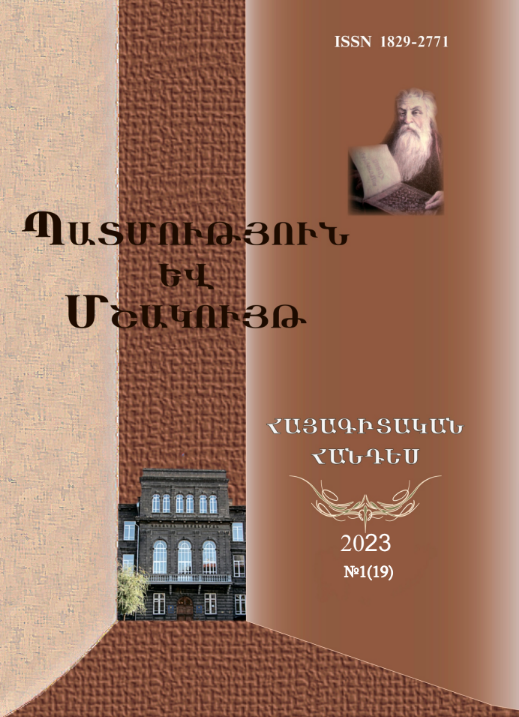Armenian Conceptions of the Most Victorious Weapon and Contemporary Khachkar Culture of Artsakh
DOI:
https://doi.org/10.46991/hc.2023.19.1.213Keywords:
Artsakh, khachkar culture, iconography, sign of victory, war, swordAbstract
From its first steps, the Christian ideology interpreted the Crucifixion first of all as a victory over death. In many medieval canonical and paracanonical stories and pictorial fictions, the cross is presented as the most victorious weapon. Christ thereby destroys hell, slays the dragon, conquers death, overcomes sin, etc. He is followed by various saints armed with cross-spears.
All this found its pictorial and especially scriptural expression in Khachkar culture. However, the medieval masters, characterizing the cross as a weapon or symbol of victory in the khachkar inscriptions, avoided making the cross look like a weapon or a sword in the khachkar composition.
After the Artsakh Liberation War, the idea of the cross as the most victorious weapon became relevant again. A new type of monuments were created, which iconographically simply represent the cross as a weapon or a sword, combining it with a shield and other military attributes. The most unique manifestation, which is fundamentally related to the liberation struggle of Artsakh, is the unique and new phenomenon in the khachkar culture: the khachkars called "sword-cross" or "border cross", which act as guardian-symbols.
References
Աբրահամյան Լ. 2019, Քրիստոսը որպես վիշապամարտիկ. եկեղեցական ավանդույթը եվ նկարչի հիշողությունը, Վիշապը հեքիաթի և իրականության սահմանին, Հնագիտության և ազգագրության ինստիտուտի հրատարակչություն, Երևան, էջ 361-370:
Ագաթանգեղոս 1914, Ագաթանգեղայ Պատմութիւն Հայոց, Թիֆլիս:
Մելքոնյան Հ. 1996, Նորահայտ արձանագրություններ Ցաղաց Քար վանքից, «Հանդէս ամսօրեայ», 62-85:
Պետրոսյան Հ. 2001, «Մանուկի» կերպարը ուշմիջնադարյան հայ տապանաքարային քանդակում (XV-XVIII դարեր) // Թուխ մանուկ, Երևան:
Պետրոսյան Հ. 2008, Խաչքար․ ծագումը, գործառույթը, պատկերագրությունը, իմաստաբանությունը, Երևան, «Փրինթինֆո»:
Սիմոնյան Լ. 2019, Քարացած վիշապները և վիշապասպան սրբերը հայոց մեջ. առասպել և հիշողություն, Վիշապը հեքիաթի և իրականության սահմանին, Հնագիտության և ազգագրության ինստիտուտի հրատարակչություն, Երևան, էջ 414-427:
Աւգերեն Մ. 1812, Լիակատար վարք եւ վկայաբանութիւն սրբոց, Վենետիկ, Վարք սրբոյն Կոստանդիանոսի թագաւորին, և մօրն նորա սուրբ դշխոյին Հեղինեայ, հ. Գ, էջ 239-273:
Քյոսեյան Հ. 2021, Հայ միջնադարայ արվեստի աստվածաբանություն, Երևան:
Օրմանեան Մ. 1979, Ծիսական բառարան, Անթիլիաս, http://www.nayiri.com/imagedDictionaryBrowser.jsp?dictionaryId=80&dt=HY_HY&pageNumber=130:
Покровский Н. 2001, Евангелие в памятниках иконографии, Москва, Прогресс-Традиция.
Холл Дж. 1996, Словарь сюжетов и символов в искусстве, пер. с английского А. Е. Майкапара, Москва, «Крон-пресс».
Евсеева Л., Комашко Н.,и др. 2002, История иконописи, VI-XX века, Москва, “АРТ-БМБ”.
Downloads
Published
Issue
Section
License
Copyright (c) 2023 Anush Safaryan

This work is licensed under a Creative Commons Attribution-NonCommercial-ShareAlike 4.0 International License.

